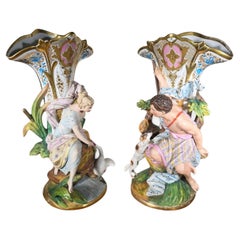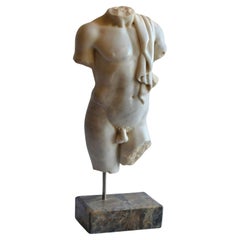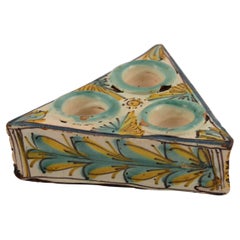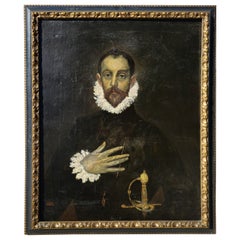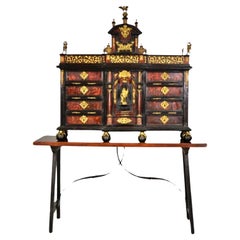Madrid - Furniture
to
410
508,276
446,105
3,524
760
227
781
581
568
204
72
52
47
46
41
22
21
16
14
12
10
7
5
4
893
991
1,640
987
231
598
406
24
10
38
21
36
181
117
241
48
9
1,903
1,483
628
522
513
3,433
959
950
560
304
4,511
3,969
4,164
122
73
68
22
21
Item Ships From: Madrid
Martin Logan Ascent / Subwoofer Velodyne / Rótel RSX - 1055 AV Amplifier / Autum
By Logan
Located in Madrid, ES
Complete Set Hight Definition
Martin Logan Ascent Speakers Pair
Year of manufacture: 2005/2006
good condition, very lightly used
Frequently Asked Questions
35–22,000 Hz ± 3 dB
Reco...
Category
21st Century and Contemporary American Modern Madrid - Furniture
Materials
Wood
An elegant pair of French porcelain vases, circa 1860
Located in Madrid, ES
An elegant pair of French porcelain vases, circa 1860, finely decorated with two detailed figures. These vases exhibit excellent craftsmanship and remain in good condition, with norm...
Category
1860s Antique Madrid - Furniture
Materials
Porcelain
Magnificent Italian Sculpture in Carrara Marble " Torso " Early 20th Century
Located in Madrid, ES
Magnificent Italian sculpture in Carrara marble " Torso " early 20th Century.
Italy
Complete height with base: 43cm
perfect condition.
Category
Early 20th Century Italian Modern Madrid - Furniture
Materials
Carrara Marble
Glazed ceramic spice rack. Talavera de la Reina, 18th century.
By Talavera de la Reyna
Located in Madrid, ES
Glazed ceramic spice rack. Talavera de la Reina, 18th century.
Spice rack with three wells in the shape of an equilateral triangle, made of ceramic and decorated with high-temperatu...
Category
18th Century Spanish Neoclassical Revival Antique Madrid - Furniture
Materials
Ceramic
Oil Painting of "The Nobleman with His Hand on His Chest" by El Greco - Copy
Located in Madrid, ES
Presenting an intriguing oil on canvas, a copy of El Greco's famous work "The Nobleman with His Hand on His Chest." This artwork is signed by the artist and dated 1924, and it is in ...
Category
1920s Vintage Madrid - Furniture
Materials
Wood
Important Spanish Cabinet, 17th Century
Located in Madrid, ES
Important Spanish Cabinet 17th century
in blackened wood and tortoiseshell veneer.
It opens with eight drawers framing a central door, surrounded by two columns.
Richly decorated w...
Category
17th Century Spanish Baroque Antique Madrid - Furniture
Materials
Bronze
Decorative Cornet. Golden metal.
Located in Madrid, ES
Decorative bugle golden metal
Decorative bugle made of golden metal. This metal wind instrument emerged, derived from the trunk of poles to which pist...
Category
20th Century European Other Madrid - Furniture
Materials
Brass
$141 / item
18th-Century Miniature Oil Painting – Virgen Dolorosa
Located in Madrid, ES
An exquisite 18th-century Sevillian miniature oil painting depicting the Virgen Dolorosa, a masterfully detailed religious artwork.
Artist: Signed by L. Ruiz
Medium: Oil on panel
Fr...
Category
1730s Antique Madrid - Furniture
Materials
Fruitwood
Brutalist Style Hand-carved Oak and Glass Mirror Italian Bar Cabinet
Located in Madrid, ES
Exquisite Hand-Carved Oak Bar Cabinet with Glass Shelves
Enhance your home with the sophisticated charm of this hand-carved oak bar cabinet. Designed with two hinged doors, this piec...
Category
21st Century and Contemporary Italian Madrid - Furniture
Materials
Oak
19th Century French Directory Cherry Wood Secetary Desk
Located in Madrid, ES
A French Directory era secretary desk, from the early 19th century, made of beautiful cherry wood, in a light tone with bronze handles and bronze keyholes as well. In their lower par...
Category
Early 19th Century French Directoire Antique Madrid - Furniture
Materials
Bronze
Modern White Felt Chair Designed By Marc Newson, Italy 90s
By Marc Newson
Located in Madrid, ES
Marc Newson's Chair for Cappellini, Italy 1993
This chair is made from a single piece of reinforced fiberglass, which is bent and molded to create the desired structure, achieving a...
Category
20th Century Italian Mid-Century Modern Madrid - Furniture
Materials
Aluminum
Pocket Watch In 18 Carat Gold, Dating From Around 1900 with calendar
Located in Madrid, ES
Discover a piece of timeless elegance with our exquisite 18K gold pocket watch from circa 1900! ⌚️
Crafted with meticulous attention to detail, this elegant timepiece boasts a classic enamel dial on one side for traditional timekeeping and a monthly and weekly calendar...
Category
1890s Antique Madrid - Furniture
Materials
Gold
Pair of Oak Wood Sideboards with Travertine Top. Italian Contemporary Design
Located in Madrid, ES
Elegant pair of contemporary sideboards handcrafted from solid oak wood, featuring a sophisticated travertine top. Each sideboard is designed with two hinged doors and an internal wo...
Category
2010s Italian Mid-Century Modern Madrid - Furniture
Materials
Travertine
Pair of wall lights in fluted glass and gilt brass
Located in Madrid, España
Pair of wall lights in fluted glass and gilt brass
Category
Late 20th Century European Madrid - Furniture
Materials
Brass
Magnificent Italian Torso Carrara Marble, Early 20th Century
Located in Madrid, ES
Magnificent Italian Torso Carrara Marble Early 20th Century H: 127cm
The height is including the base
good conditions
weight: 800kg
This sculpture needs export certificate
Delivery t...
Category
Early 20th Century Italian Modern Madrid - Furniture
Materials
Carrara Marble
AMAZING NAPOLEON III CABINET 19th Century
Located in Madrid, ES
AMAZING NAPOLEON III CABINET 19th Century
French, 19th century
in ebonized wood, gilded bronze applications "caryatids, masks, allegories and vegetal motifs".
Box with two doors, in...
Category
19th Century French Napoleon III Antique Madrid - Furniture
Materials
Bronze
Brutalist Style Sideboard Made of Wood and Siena Marble, Italy
Located in Ibiza, Spain
Wooden sideboards with two hinged doors, designed for both functionality and elegance. The top and base are crafted from premium Siena marble, providing durability and a sophisticate...
Category
21st Century and Contemporary Italian Modern Madrid - Furniture
Materials
Siena Marble
Nineteenth Century Brass Cigarette Case
Located in Madrid, ES
Nineteenth Century Brass Cigarette Case
19th century cigarette case, brass and ornaments.Dimensions: 15x8x3 cm cm
Category
1880s Antique Madrid - Furniture
Materials
Brass
$330 Sale Price
20% Off
Last Supper. Oil on panel. Castilian School, 16th century.
Located in Madrid, ES
Last Supper. Oil on panel. Castilian School, 16th century.
It has faults.
An oil on panel painting depicting a figurative image against a neutral background, with a checkered tile...
Category
16th Century Spanish Renaissance Antique Madrid - Furniture
Materials
Other
Set Mod. Togo Designed By Michel Ducaroy For Ligne Roset
By Michel Ducaroy, Ligne Roset
Located in Madrid, ES
Set mod. Togo designed by Michel Ducaroy for Ligne Roset. Reupholstered in yellow leather. France 70's.
Dimensions: W265 x D 190 x H 35 / 70 cm
Double armchair size: W 120 x D 100 ...
Category
1970s French Modern Vintage Madrid - Furniture
Materials
Leather
PAIR OF 20th Century KUDU HUNTING TROPHIES
Located in Madrid, ES
PAIR OF 20th Century KUDU HUNTING TROPHIES
Chest mount, Rowland Ward R.S.A Zimbawe.
Approx. length: 187 cm.
very good condition
Category
20th Century South African Modern Madrid - Furniture
Materials
Animal Skin
PORTUGUESE SECRETARY 19th Century in Rosewood
Located in Madrid, ES
SECRETARY
Portuguese 19th Century
in rosewood and other woods.
Twisted and shaky, front with eight drawers and one drawer, sides and padded back.
Brass hardware.
Dim.: 80 x 140 x 75...
Category
19th Century Portuguese Renaissance Antique Madrid - Furniture
Materials
Wood
Green patinated wood bench - Casa Diez - Spain - c. 1970
Located in Madrid, España
Green patinated wood bench - Casa Diez - Spain - c. 1970
Category
1970s Spanish Vintage Madrid - Furniture
Materials
Wood
Pre-Columbian ceramics can– Tiahuanaco Culture
Located in Madrid, ES
"Pre-Columbian Ceramics – Tiahuanaco Culture"
Material: ceramics
Origin: Southern Sierra of Peru, Lake Titicaca Plateau
Period: Boom Age (1 AD – 800 AD)
Dimensions: 11 x 10 cm diamet...
Category
15th Century and Earlier South American Tribal Antique Madrid - Furniture
Materials
Ceramic
Oil on Canvas Titled "Nicolina" — Basque Artist, Late 19th Century
Located in Madrid, ES
"Nicolina" – Late 19th Century Oil on Canvas by a Basque Artist
A captivating and intimate oil on canvas titled "Nicolina," attributed to a Basque artist of the late 19th century. T...
Category
Late 19th Century Spanish Romantic Antique Madrid - Furniture
Materials
Canvas
Huge Tuscan Terracotta Statue - 145 cm
Located in Madrid, ES
A large sculpture made from Tuscan Impruneta terracotta, personifying Venus with the Shell. Standing at 145 cm tall, this impressive piece is in good condition. The statue beautifull...
Category
Late 20th Century Madrid - Furniture
Materials
Terracotta
18th Century Set Six Swedish Chairs Gustavian Period
By Melchior Lundberg
Located in Madrid, ES
A set of six elegant and exceptional Swedish chairs from the Gustavian period, two of which are marked by Melchior Lundberg, a chairmaker in Stockholm (1714-1816). Woodcut decoration...
Category
Late 18th Century Swedish Gustavian Antique Madrid - Furniture
Materials
Pine
$11,696 / set
Leonard Bordier 18K Gold Pocket Watch with Pearls and Enamel – Made for the Chin
Located in Madrid, ES
An exquisite late 18th-century pocket watch signed by Leonard Bordier, crafted circa 1790, in 18K gold with fine enamel work and adorned with original pearls. This exceptional piece ...
Category
1790s Antique Madrid - Furniture
Materials
Gold
Reliquary Cross Pendant, Silver, Glass, 17th-18th Century
Located in Madrid, ES
Devotional pendant made in silver with a Latin cross shape, decorated on the outside with simple scrolls, spikes, pearls and other elements of classicist inspiration, as well as a ri...
Category
18th Century European Neoclassical Antique Madrid - Furniture
Materials
Silver
Pair of Decorative Horses – 1950s
Located in Madrid, ES
Charming and eye-catching pair of decorative horses from the 1950s, finely crafted in solid wood and embellished with copper fittings and mother-of-pearl inlays. These pieces reflec...
Category
Mid-20th Century Madrid - Furniture
Materials
Fruitwood
18th Century Spanish Virgin Mary of Immaculate Conception, Handcrafted Sculpture
Located in Madrid, ES
Completely hand-crafted in 18th century Spain, this sculpture of the Virgin stands 1.5 meters / 5 feet tall and was most certainly created for devotional purposes, to be displayed in a church or chapel.
Besides its impressive size this sculpture is an excellent, museum-quality example of the Spanish “Estofado” polychrome technique, developed during the Gothic period to imitate rich brocade fabrics. The finely carved “fabric” areas of the sculpture would be first covered in gesso, and then a layer of gold leaf would be applied. The gold leaf would then be painted over with various colors of tempera paints. Once dry, the painted surface would be incised or scratched away in patterns, revealing the gold beneath.
The sculpture was professionally restored in 2022 by a firm that is often hired by the Spanish government to work on historic building interiors and museum pieces. The virgin was carefully cleaned, repaired and its condition stabilized. A complete and fully-illustrated restoration report will be included with purchase.
Often confused with the virgin birth of Jesus, the belief that the Blessed Virgin Mary herself was conceived “immaculately” without original sin has been variously defended and debated within the Catholic Church since the pre-Middle Ages. For centuries, artists struggled to create an acceptable visual representation of this highly abstract concept, in part taking inspiration from the Book of Revelation and other scriptural sources.
We see the Virgin standing on a half moon (biblically inspired, though also an ancient symbol of chastity) with her long natural hair loose down her back, another indication of purity. Both her white tunic and flowing blue mantle...
Category
18th Century Spanish Baroque Antique Madrid - Furniture
Materials
Silver, Gold Leaf
Large Garden Sculptures of the Four Seasons – 230 cm
Located in Madrid, ES
Transform your garden with this magnificent set of four iron-cast sculptures, each embodying one of the four seasons in a classic and timeless style. Crafted in Italy during the 1970...
Category
1960s Vintage Madrid - Furniture
Materials
Iron
Pocket Watch, Jaqs Blanc, Gold, Enamel, Etc. Possibly ca Late 18th C
Located in Madrid, ES
Pocket watch, Jaqs Blanc. gold, enamel, etc. Possibly towards the end of the 18th century.
Pocket watch with a white dial and Arabic numerals for the hours and lines and Arabic num...
Category
Late 18th Century Neoclassical Antique Madrid - Furniture
Materials
Metal, Gold, Enamel, Other
North African Sword (Nimcha), Morocco, Early 19th Century
Located in Madrid, ES
North African Sword (Nimcha), Morocco, Early 19th Century
This North African sword, known as a "Nimcha," is a remarkable piece originating from Morocco, dating back to the early 19th...
Category
Late 19th Century Antique Madrid - Furniture
Materials
Wrought Iron
$1,105 Sale Price
20% Off
17th-century Flemish cabinet with mythological paintings and silver decoration
Located in Madrid, ES
"17th-century Flemish cabinet with mythological paintings and silver decoration"
Period: 17th century
Materials: Wood, oil on panel, solid silver, mirrors
Overall dimensions: 160 x ...
Category
17th Century Belgian Baroque Antique Madrid - Furniture
Materials
Wood, Ivory
Magnificent Italian Torso Carrara Marble, Early 20th Century
Located in Madrid, ES
Magnificent Italian Torso Carrara Marble Early 20th Century H: 48cm
The height is including the base
Good conditions.
Category
Early 20th Century Italian Modern Madrid - Furniture
Materials
Carrara Marble
Brass and copper parrot with glass eyes - Sergio Bustamante - Mexico - c. 1970
By Sergio Bustamante
Located in Madrid, España
Brass and copper parrot with glass eyes - Sergio Bustamante - Mexico - c. 1970
Dimensions: 83 x 40 x 27 cm (total dimensions with swing)
Category
Late 20th Century Mexican Madrid - Furniture
Materials
Brass
Peter Paul Rubens Circle of "Saint Catherine " Never Restored First Canvas
By Peter Paul Rubens
Located in Madrid, ES
Peter Paul Rubens (Siegen 1577 - Antwerp 1640) circle of
Saint Catherine of Alexandria
Never Restored First Canvas
Oil on canvas
129.5 x 94 cm
The work is based on the painting by Peter Paul Rubens and engraved by Schelte von Bolswert.
Rubens, known as "the Prince of the Baroque", was the great master who revolutionized both Flemish and European painting. His first training took place thanks to the masters Otto van Veen and Jan Brueghel the Elder. His trip to Italy, where he stayed, studied and painted for eight years, was fundamental to his artistic growth. His first stop was Venice, where Titian, Veronese and Tintoretto studied. He later came into contact with Vincenzo I Gonzaga, Duke of Mantua, becoming the court painter of the family, a position he held until the end of his stay in Italy. In Mantua, Rubens had the opportunity to study the rich ducal collection closely and assiduously. By making copies of several famous paintings he was able to practice technically on the examples of the greatest masters. In 1601 he was sent by the duke to Rome, where he was able to further broaden his figurative horizons thanks to the copying of the models of Michelangelo and Raphael and the study of the ancient, also looking at the contemporary artistic production of Carracci, Caravaggio and Federico Barocci. After leaving Italy, he settled in Antwerp, where he organized his atelier, applying the methods of organized production, that is, employing his collaborators with rational criteria and on the basis of individual specializations. Among the many painters who came out of Rubens' workshop or were strongly influenced by the master, we remember: Cornelis and Paul de Vos, Jacob Jordaens, Pieter Van Mol, Victor Wolvoet, Joanna Vergouwen, Jan Boeckhorst known as Lange Jan, Lucas Van Uden, Theodor Van Thulden, Peter Van Lint, Willem Van Harp, Vincent Adrianssen, Pieter Van Avont, Jan and Hendrick van Balen, Theodor Boeyemans or Boeijermans, Vincent Malò...
Category
17th Century German Baroque Antique Madrid - Furniture
Materials
Paint
IMPORTANT FEMALE FIGURE WITH SWING HEAD Qing Dynasty Yongzheng period (1723-1735
Located in Madrid, ES
IMPORTANT FEMALE FIGURE WITH SWING HEAD Qing Dynasty Yongzheng period (1723-1735)
In export china,
Qing Dynasty Yongzheng period (1723-1735) with articulated head, polychrome and gi...
Category
Mid-18th Century Chinese Chinese Export Antique Madrid - Furniture
Materials
Porcelain
Extremly Rare Mexican Silver Miquelet-Lock Blunderbuss Belt Pistol Flintlock
Located in Madrid, ES
Extremly Rare South American Silver-Mounted Miquelet-Lock Blunderbuss Belt Pistol
Late 18th century, Mexican
With a roped silver band around the turned and belled muzzle, the forward sections polygonal and inlaid with silver fronds, octagonal breeches with silver foliage on the flats either side, a broad silver band at the rear, foliate engraved tangs, characteristic locks with fluted mount beneath the pan enclosing the steel-spring, full stocks inlaid with silver panels secured by silver pins and pierced and engraved with foliage inhabited by monsters, birds and a pair of rabits, the last forward of the trigger-guards, and studded with further silver pins.
The fore-ends en suite and each inlaid with a silver panel pierced and engraved as a double-headed eagle, foliate engraved silver side-plates each pierced for an iron belt hook...
Category
18th Century Antique Madrid - Furniture
Materials
Sterling Silver
$30,528 Sale Price
20% Off
18th Century Portuguese "Azulejos" Panel "Romantic Scene"
Located in Madrid, ES
Largest collection of Portuguese tiles in the world
18th century Portuguese " Azulejos " Romantic Scene"
Measures: 252cm x 140cm
170 tiles
Important note: This panel is with the t...
Category
18th Century Portuguese Baroque Antique Madrid - Furniture
Materials
Ceramic
Florian Schulz Model Onos 40 Double Counterbalance Pendant Lamp
By Florian Schulz
Located in Madrid, ES
Pendant lamp designed by Florian Schulz and produced in Germany. Height-adjustable structure with double counter-balance in the middle, which can be shifted at sides. Made of brushed...
Category
2010s German Modern Madrid - Furniture
Materials
Metal, Nickel
$3,809 Sale Price
29% Off
Børge Mogensen for FDB Møbler Teak Cabinet Model 232
By Børge Mogensen, FDB Møbler
Located in Madrid, ES
Cabinet of teak, later mounted on unoriginal oak feet of slightly lighter color. Front with two doors. Interior with two shelves and four pullout trays. Manufactured in Denmark by FD...
Category
Mid-20th Century Danish Scandinavian Modern Madrid - Furniture
Materials
Brass
Rare Gramophone Made for the Gramophone Exhibition in Seville in 1925
Located in Madrid, ES
A very unique and rare gramophone made by a Seville jewller for the Gramophone Exhibition in Seville in 1925 in wich was awarded with a silver medal.It was...
Category
20th Century Spanish Islamic Madrid - Furniture
Materials
Silver
1950 Mid Century Mathieu Mategot Perforated Metal and Brass Table Lamp
By Mathieu Matégot
Located in Madrid, ES
Table lamp from the 50s designed by Mathieu Mategot, in lacquered metal and gilded brass, three lampshades in perforated metal and in off-white color, it retains all its original ele...
Category
Mid-20th Century French Mid-Century Modern Madrid - Furniture
Materials
Metal, Brass
MAGNIFICENT AND RARE EUROPEAN CRADLE 18th Century
Located in Madrid, ES
MAGNIFICENT AND RARE EUROPEAN CRADLE 18th Century
in painted and gilded wood with scrolls, puttis and profuse floral decoration.
Small defects.
Dim.: 68 x 94 x 43 cm
good conditions
Category
Early 18th Century European Baroque Antique Madrid - Furniture
Materials
Wood
Mid-Century Modern Charlotte Perriand Mod. CP1 Pair Of Red French Sconces
By Charlotte Perriand
Located in Ibiza, Spain
Set of two sconces designed by the iconic Charlotte Perriand for Steph Simon, circa 1960. These mid-century modern wall lights feature an adjustable main structure, allowing for flex...
Category
1960s French Mid-Century Modern Vintage Madrid - Furniture
Materials
Metal
Mid-Century Modern Solid Wooden Desk Designed by Arne Vodder Boomerang
By Arne Vodder
Located in Ibiza, Spain
The Boomerang desk, designed by Arne Vodder in Denmark during the 1960s, showcases a solid teak wood structure adorned with brass details on the legs. This iconic piece features thre...
Category
1960s Danish Mid-Century Modern Vintage Madrid - Furniture
Materials
Brass
Gilt bronze pax board, Pietà. 16th-17th centuries, after Michelangelo Buonarroti
Located in Madrid, ES
Peacekeeper, Mercy. Golden bronze. Possibly Rome, last third of the 16th century-first quarter of the 17th century, following the model of Michelangelo Buonarroti.
Gilded bronze pla...
Category
Early 17th Century European Renaissance Antique Madrid - Furniture
Materials
Other, Bronze
16th-Century Aragonese Walnut and Bone Marquetry Chest
Located in Madrid, ES
This exceptional 16th-century chest is a masterful example of Aragonese craftsmanship, combining rich walnut wood with intricate geometric bone marquetry inspired by Islamic artistic...
Category
16th Century Antique Madrid - Furniture
Materials
Fruitwood
Large Sculpture by Frederic Remington
Located in Madrid, ES
Bronze sculpture signed: Frederic Remington from the 1950s. It is in very good condition. Measures: 104 cm height.
Category
1950s Vintage Madrid - Furniture
Materials
Bronze
Huge Red Coral Necklace
Located in Madrid, ES
Huge Red Coral Necklace
Huge polished red coral beads complete this fascinating 67cm long necklace. The largest red coral bead is: 35 x 34 mm .436 grams in weight
Category
1940s Vintage Madrid - Furniture
Materials
Coral
$4,205 Sale Price
20% Off
Italian School "Apostle" 17th Century
Located in Madrid, ES
Italian School
"Apostle" 17th Century
Oil on oak wood
Carved and gilded wooden frame.
Small defects.
Dim.: 44 x 58 cm
good conditions
Category
17th Century Italian Baroque Antique Madrid - Furniture
Materials
Paint
Mid-Century Modern Style Oak Wood and Black Glass Italian Sideboard
By L.A. Studio
Located in Ibiza, Spain
This Italian sideboard, designed by L.A. Studio, features a sophisticated composition with two central sliding doors and two folding doors. Crafted from solid oakwood, its structure ...
Category
21st Century and Contemporary Italian Mid-Century Modern Madrid - Furniture
Materials
Glass, Oak
AMAZING MARBLE FIGURE OF THE MINOTAUR, 17th Century Baroque Style, Italy.
Located in Madrid, ES
MARBLE FIGURE OF THE MINOTAUR, 17th Century
Baroque Style, Italy.
Beige/grey marble. Minotaur on a rectangular "Rosso di Verona" base. H (without base) 81 cm.
H (without base) 81 c...
Category
17th Century Italian Baroque Antique Madrid - Furniture
Materials
Marble
RENAISSANCE TWO BODY CABINET 19th Century
Located in Madrid, ES
RENAISSANCE TWO BODY CABINET 19th Century
In oak wood
Upper part with two profusely carved doors.
Lower part with two drawers and two doors.
Decorated with plant motifs, zoomorphic ...
Category
19th Century Portuguese Baroque Antique Madrid - Furniture
Materials
Wood
Helge Vestergaard-Jensen Light Grey Painted Wood Sideboard
By Peder Pedersen, Helge Vestergaard-Jensen
Located in Madrid, ES
Elegant sideboard designed by Helge Vestergaard-Jensen circa 1955 and produced by master cabinetmaker Peder Pedersen. Made of veneered wood, unoriginal light grey color paint of late...
Category
Mid-20th Century Danish Mid-Century Modern Madrid - Furniture
Materials
Wood
Ettore Sottsass Contemporary Modern "Demistella" Marble Italian Console
By Ettore Sottsass
Located in Ibiza, Spain
The "Demistella" console, designed by Ettore Sottsass for Up & Up, features a solid wood structure with briar root and lacquered wood accents. Its cylindrical legs are crafted from M...
Category
1990s Italian Modern Madrid - Furniture
Materials
Marble
Round walnut dining table in the style of Afra and Tobia Scarpa, Italy, 1970
Located in Madrid, ES
Round dining table in the style of Afra and Tobia Scarpa, handcrafted from walnut plywood. The base is characterised by its cross-shaped structure, which is finished at the top with ...
Category
1970s Italian Modern Vintage Madrid - Furniture
Materials
Walnut
Huge Red Coral Necklace
Located in Madrid, ES
Huge Red Coral Necklace
Huge polished red coral beads complete this fascinating 60cm long necklace. The largest red coral bead is: 25 x 15 mm .550 grams in weight
Category
1940s Vintage Madrid - Furniture
Materials
Coral
$5,151 Sale Price
20% Off

